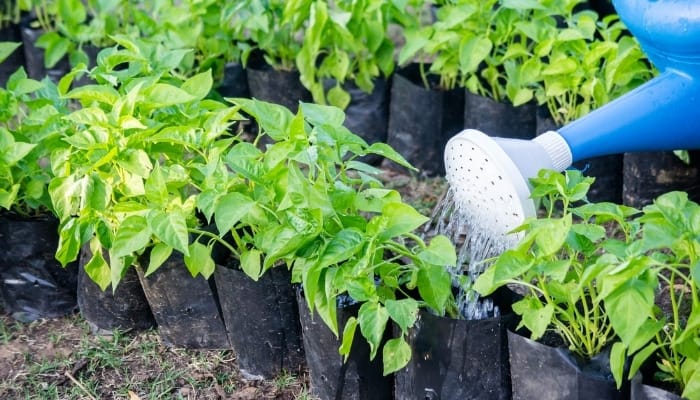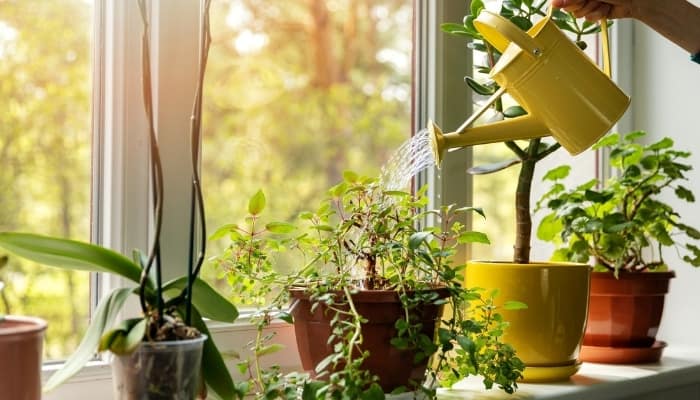If you are a beginner in gardening or seeking to improve your gardening abilities and give proper care to your plants, familiarizing yourself with reverse osmosis water and considering its use is highly recommended.
Is reverse osmosis water good for plants? Reverse osmosis water is not only good for plants, it is practically the very best water you can give them. Using reverse osmosis water allows you to have nearly complete control over how much nutrients your plants are exposed to and take up. For delicate plants, reverse osmosis water is a must.
Read on below and learn more about reverse osmosis water for plants, including why and when to use it!
Reverse Osmosis Water for Plants
Water treated with reverse osmosis is often considered the best water for plants. That’s not to say it’s the most nutrient or oxygen packed (that would be spring water), but it is the cleanest water.
It has the least amount of contaminants of any sort of water you can give your plants because this form of water is basically void of everything.
In the following sections, we break down everything from how reverse osmosis works in general to how it stacks up against other purified forms of water and more.
What Is Reverse Osmosis Water?
Reverse osmosis water is produced by a process that forces water with the use of pressure through a semi-permeable membrane.
The result is that the vast majority of contaminants found in the water are removed, including heavy metals, salts, chlorine, and more.
Reverse osmosis water is therefore even more pure than distilled water.
Does Reverse Osmosis Remove Minerals?
Reverse osmosis removes between 90 and 99.99% of “contaminants” from water, including minerals and nutrients.
Minerals have larger molecules than water does, so when the water moves through the semi-permeable membrane, the minerals are caught and removed.
Does Reverse Osmosis Remove Chlorine?
Regular reverse osmosis alone is not enough to remove all of the chlorine present in water.
However, adding a block of carbon to the reverse osmosis equipment/process is an efficient way to remove up to 98% or more of the present chlorine from water.
Reverse Osmosis Water pH
The final product, when using the reverse osmosis process to purify water, ends up having a pH of between 6.0 and 6.5.
However, some reverse osmosis water is a bit more acidic, measuring well up into the 7.0 to 7.5 pH range.
Do Plants Like Reverse Osmosis Water?
Reverse osmosis is perfectly acceptable for plants, and many of them even prefer it over distilled or tap water because it lacks heavy metals or other contaminants that mess with their fertilizer and pH levels.
Benefits of Using Reverse Osmosis Water for Plants
The primary benefit of using reverse osmosis water for plants is that you have a steady supply of clean and uncontaminated water.
The next best thing is that you get to control exactly what goes into the reverse osmosis water, giving your plants exactly what they need and avoiding everything they don’t need.
Disadvantages of Reverse Osmosis Water for Plants
Reverse osmosis water has only two major disadvantages: it is more expensive than tap water or distilled water, and it removes practically ALL contaminants, even the good ones.
If budget is a concern and you don’t mind adding nutrients and pH balancers to your water, reverse osmosis is great for you.
Reverse Osmosis vs. Distilled Water for Plants
Both reverse osmosis and distiller water are better for plants than regular tap water or even rainwater in many cases.
That said, the two processes are very different, albeit similar in that they both remove contaminants.
Distillation is a process that captures “pure” water from the condensation built up from boiling water at intense temperatures.
Reverse osmosis is done by forcing water through semi-permeated membranes to remove contaminants.
When You Should Use Reverse Osmosis for Your Plants
Reverse osmosis water is good for drinking water as well as to water plants in all sorts of growing systems.
Whether it’s outside in the flower beds, inside in containers, or even in hydroponic and aquaponic water reservoirs, reverse osmosis is a far superior solution than tap water or even distilled water as it allows for a more stable pH.
What Is the Best Water for Plants?
Rainwater and water from natural springs are the best water for plants, hands down. That said, reverse osmosis is a close second and sometimes even a better option than the latter two.
That’s because with reverse osmosis water, you are taking water down to an extremely “pure” level and are able to build it up with whatever nutrients your plants need the most.

Distilled Water for Plants
Distilled water is a better option than tap water in most households. However, that isn’t actually saying much.
Distilled water is, however, technically cleaner than just about any water other than natural spring water and reverse osmosis water.
It is also crucial to note that plants watered with distilled water rather than “normal” water do grow faster and more vigorously because all distilled water does is hydrate the growing medium.
Distilled water doesn’t add vitamins or minerals to the growing medium.
Rain Water for Plants
Rainwater is much better for plants than most tap water. That’s because it lacks the fluoride and heavy metals found in tap water.
Besides reverse osmosis water and natural spring water, rainwater is the next best thing for your plants.
Filtered Water for Plants
Filtered water for plants is also quite an acceptable solution. That said, it may be expensive to filter water or purchase it.
Furthermore, depending on the type of filtration system used, it may not actually make the water all that much better. However, in most cases, it is at least a step up from tap water.
Spring Water for Plants
Natural spring water is often seen as the best type of water for plants. One of the primary reasons it’s so good for them is that it’s oxygen-rich compared to other types of water.
Even if you put it through a filter, spring water is still better for plants than other types of distilled or filtered water, including most rainwater.
Best Water for Indoor Plants
Rainwater and distilled water are often considered the best types of water you can give your plants. That said, reverse osmosis water is arguable better than both options, as is natural spring water.
The best type of water for your indoor plants boils down to how much time you want to spend filtering, collecting, or adding nutrients to your water.
Conclusion
Reverse osmosis water is an excellent solution for your plants.
It’s better than distilled water and filtered water, and it’s cleaner than rainwater these days as well. The only real competition out there is spring water.
The downsides to reverse osmosis water are that it’s an expensive process to use continually and that it removes everything from the water, even the good vitamins, nutrients, and other minerals.

